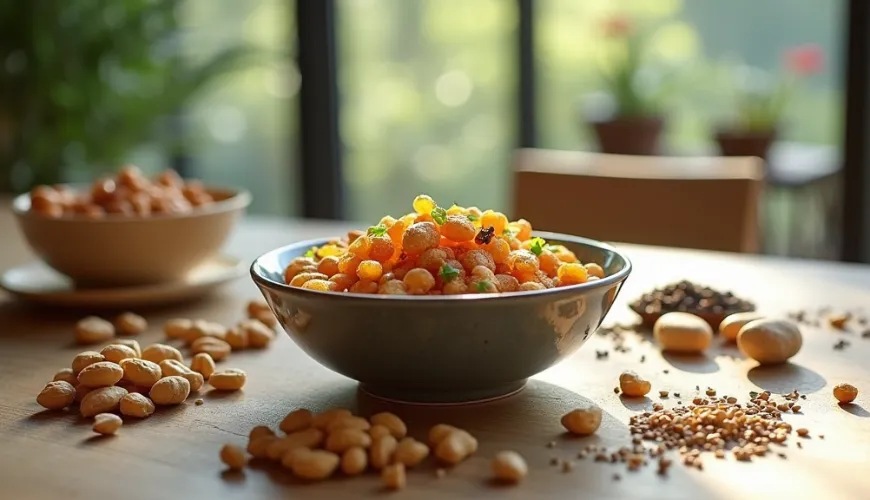
Where does the Japanese mixture actually come from and how did it develop?

What Exactly is Japanese Mix and Why Has It Gained So Many Fans?
When you hear "Japanese mix," most people envision crunchy nuts coated in a spicy crust, often found on store shelves among other salty snacks. But Japanese mix isn't just another cinema snack or something for evening gatherings. Behind it lies a fascinating story about the influence of Asian cuisine on global tastes, the fusion of traditional ingredients with modern techniques, and how people gradually began to ask themselves: what exactly are we eating?
At a time when more people are looking for healthier alternatives to common foods and focusing on the origin of ingredients, even something as seemingly simple as Japanese nut mix becomes a subject of interest. And it's no wonder. Its composition can vary significantly depending on the manufacturer – and some varieties share only the name with traditional Japanese cuisine.
Where Does Japanese Mix Originate From?
Although the name suggests it's a traditional Japanese dish, the truth is a bit more complex. The real Japanese nut mix, known in Japan as arare or senbei, has roots in East Asia and originated from rice crackers often flavored with soy sauce or seaweed. In the Western world, however, Japanese mix has evolved into a completely different product. The mix we know in Europe is more of an American or European creation inspired by Japanese ingredients – and adapted to local tastes.
The true origin of this type of snack dates back to the mid-20th century when Asian cuisine began to penetrate Western culture. Manufacturers soon noticed that the combination of salty and spicy flavors, crunchiness, and exotic appearance had potential – and so the Japanese mix was born in the form we know today.
What is the Composition of Japanese Mix?
This might be the most interesting question. If you ever read food labels, the composition of Japanese mix might surprise you. While some types contain only natural ingredients like peanuts, rice balls, sesame, and seaweed, others can be full of glutamates, artificial colors, sugar, or palm oil. And that's the crucial difference.
The traditional Japanese mix, as we know from Asian markets, has a simple composition:
- Peanuts or other nuts
- Rice crackers (senbei, arare)
- Sesame seeds
- Seaweed (nori)
- Soy sauce
These ingredients are combined to create a balanced mix of flavors – sweet, salty, umami – and also different textures, from soft to extra crunchy. Modern versions of the mix, however, include additives like starch flours, sugar, glucose syrup, various stabilizers, and flavor enhancers, which extend shelf life and enhance taste appeal but also make consumers ponder their health impact.
Therefore, it's important to read labels and choose a Japanese mix that contains as few additives as possible and as many natural and plant-based ingredients without artificial additives. For example, those found in stores focused on a healthy lifestyle.
Nuts in a Different Way - Tasty and Nutritious Alternative
Japanese mix is not just about taste and exoticism. If prepared correctly, it can be a healthier alternative to common salty snacks. Peanuts are rich in protein, healthy fats, and fiber. Rice crackers, if not fried, can be easily digestible and naturally gluten-free. Seaweed contains iodine, B vitamins, and antioxidants.
The decisive factor, however, is the method of preparation. Baked or dried components are significantly more beneficial than those fried in oil. If the manufacturer uses quality soy sauce (without glutamate and preservatives), the final product can be not only tasty but also nutritious.
In Japan, for example, Japanese mix is often served as a side dish to tea or as part of a light meal. It's more of a cultural experience than just a quick satiation.
"Food is a reflection of culture – and Japanese mix shows how cultural influences can mix and create new flavors," says Japanese chef and cookbook author Naomi Kijima in an interview for The Japan Times.
How to Recognize Quality Japanese Mix?
In a supermarket where the shelf is packed with dozens of different mixes, it's not easy to recognize which one is really worth it – and that's why it's good to know what to look for when choosing. The first thing that should catch your attention is the composition on the package – if the list of ingredients isn't as long as a Christmas shopping list and the individual ingredients are familiar even without googling, you have a decent foundation. Then also check where the items in the mix come from – ingredients with a clear origin or even a BIO label are definitely a step in the right direction.
The method of processing is also important – ideally, opt for those that are baked, not fried, as they contain less fat and usually less unnecessary chemicals. And speaking of chemicals: avoid mixes that add monosodium glutamate (E621), artificial sweeteners, or colorants to their recipe – these are things that certainly don't need a place in a healthy diet. So for me – read, choose wisely, and don't be lured just by an attractive package.
For example, in e-shops focused on ecology and a healthy lifestyle, like Ferwer, you'll find products that care not only about taste but also about transparency. You'll also appreciate the eco-friendly packaging – a frequent benefit of sustainable production.
Inspiration from Home
At a time when more and more people are trying to reduce plastic waste and shop package-free, the question arises: can you make Japanese mix at home? The answer is – definitely yes.
All you need are a few basic ingredients: natural peanuts, rice crackers (which can be made at home from rice flour, water, and a bit of oil), sesame, nori seaweed, and quality soy sauce. Everything is mixed and lightly roasted in the oven or in a dry pan. The advantage is that you can control the ingredients, adjust the flavor to your liking, and avoid unnecessary additives.
Moreover – home preparation is fun. Similar to baking granola or making homemade hummus, preparing your own Japanese mix can become a favorite part of weekend cooking. You can even involve children, who will love mixing their own combination.
A Small Snack with a Big Story
Japanese mix is more than just a nut mix. It is a cultural fusion that connects Eastern tradition with the global world and at the same time shows how important it is to pay attention to what we eat. It is fascinating that a product that looks like an ordinary snack can provoke such deep questions about the origin of food, sustainability, and our relationship with food.
Next time you reach for a pack of Japanese mix, try to pause for a moment. Read the composition, think about the origin of the ingredients, and perhaps consider a homemade alternative. In today's world, where it is increasingly easier to live consciously and sustainably, it is a small step that can lead to a big change.

